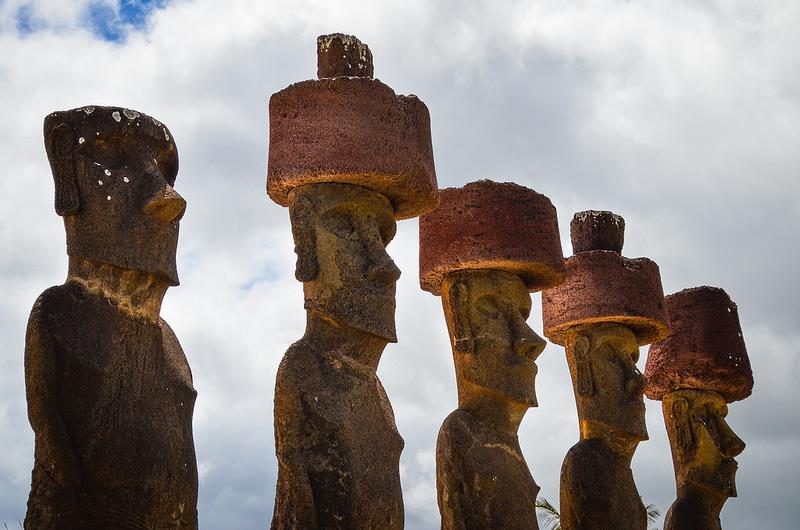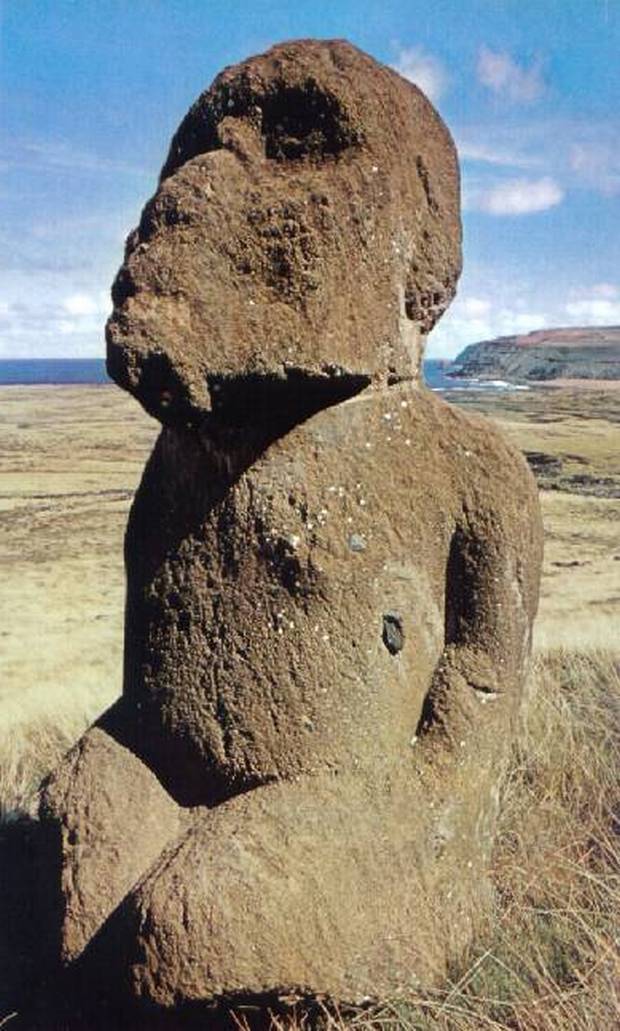It is said that Easter Island is one of the loneliest places in the world. A pinprick of land in the watery expanses of the South Pacific has a history of unique sculpture. Huge stone statues, the most enigmatic in the world, were known from the island’s extinct volcanic crater and dragged into place.
This tiny and remote island – almost 1200 miles (2000km) from its nearest island neighbours, about twice that distance from a large landmass, and just 16 miles (25km) long – prompts many puzzling questions. Where did the first inhabitants come from? How did they find the island at all? And why and how did they construct and erect more than 6000 giant stone statues, only to later tear most of them down?
The first Europeans to set foot on the island, on Easter Sunday 1722, were Dutch sailors. They stayed ashore long enough to name the island and for their admiral to note that he judged the islanders to be of two different racial types. He also recorded that they appeared to worship colossal statues carved from stone. (In fact, the statues were cut from badly eroded volcanic rock.) in 1770 a party of Spaniards from Peru rediscovered Easter Island. At that time, the island’s population was estimated at 3000: just four years later, during his second Pacific voyage of discovery, English explorer James Cook found between 600 and 700 men and just 30 women. Numbers recovered slightly in the early 19
At that time, the island’s population was estimated at 3000: just four years later, during his second Pacific voyage of discovery, English explorer James Cook found between 600 and 700 men and just 30 women. Numbers recovered slightly in the early 19th century, but were dealt another blow in the early 19th century, but were dealt another blow in the 1860s, when the Peruvian government took between 1000 and 2000 men to work as slaves on the mainland. In 1865, the 15 survivors were returned to the island; with them they carried smallpox. Having no resistance, the islanders succumbed to the disease.
The dwindling population helps to explain why the islanders’ origins are so poorly understood. There were no written records on Easter Island, and with every death the oral tradition and the culture it described became less and less clear. And, although many wooden tablets carved with pictograms have been found on the island, as yet no one has been able to interpret the symbols.

Island houses were made from lava with a covering of turf on the roof slabs. From about 1500, the village of Orongo was the centre of the Birdman cult. Terns nest on many of the small islands off the shore near Orongo, and the eggs of these sea birds were an important source of food for the islanders. The man who collected the first egg in spring became Birdman and supreme island chief for a year. A figure of the Birdman is carved on a large rock overlooking the islet of Motu Nui.

Natives told James Cook that 22 generations had passed since Chief Hotu Matu’s had led their ancestors to the island, but they could not say from where. Statues on the Nau Nau platform in Anakena Bay, restored in 1978, stand with their backs to the place where Chiedf Hotu Matu’a is said to have landed. He named the island Te Pito o te Henua, ‘the navel of the world’, probably a reference to its extreme isolation.

There are two major theories, both of which may be correct to a certain extent. If they are, this would explain why visitors to Easter Island, from the Dutch admiral on, have noted that the islanders seem to be of two different racial types.
According to the first theory, put forward in the 1930s by Alfred Metreaux, the islanders’ ancestors came from other Polynesian islands to the west. Many archaeologists favour this suggestion: there are cultural similarities between Easter Island and others in the Polynesian group, and the voyage would have been shorter for would-be colonisers than if they had come from the east.
The second theory, now considered less unlikely, was proposed in the 1930s by the Norwegian archaeologist and anthropologist Thor Heyerdahl. He pointed out the physical similarities between many of the long-headed Easter Island statues and some South American peoples. He argued that the staple island crop, the sweet potato, could only have come from the Amazon region, and that seed dispersal over such distances was unlikely. Finally, by crossing the Pacific from the coast of South America to Polynesia on the Kon-Tiki, a raft made from balsa logs, he proved that such a journey was possible.
Wherever they came from, and whoever they were, the Easter Islanders constructed some of the most famous stone statues in the world. Anthropologists, by studying the remains of the statues and other man-made artefacts and by listening to fragments drawn from legend, have identified three cultural periods in the island’s history.
During the first, or early, period, from about AD 380, most statues were of kneeling human figures carved from volcanic slag or basalt. In the second, or middle, period which began around 1100, the type of statue which is now most commonly associated with the island became prominent. This was the moai, with the elongated upper body of a man, a stylized head, inlaid eyes and long ear lobes. The statues stood on stepped stone platforms called ahu, which supported up to 12 figures. Over the centuries, ever larger statues were fashioned and a red topknot, or pukao, was added to the heads. These images, thought to represent chiefs deified after death, are unique.
The earliest statues depict kneeling men. Unlike later statues, which were made from a uniform material, different types of stone were used for early examples. The similarities between these statues and figures found in pre-Inca South America support Heyerdahl’s theory that some of the islanders originated there.

Many moai have eyes carved from white coral, with red scoria rock as irises. It is thought that the eyes were inserted only when the statues had ben hoisted into position at their final resting place. Material for the statues was hewn from a volcanic crater at Rano Raraku in the east of the island; the red tuff rock for the topknots came from a crater at Punapau in the west.

Some statues still stand with their lower halves buried in pits. The figures were tipped into holes in the ground to enable carvers to finish their backs.

The beginning of the third, or late, cultural period in about 1680 seems to have coincided with the outbreak of civil war between the two peoples who had previously co-existed peacefully. This may have begun when trees started to become scarce: boats for fishing could not be replaced and the soil deteriorated.
It is believed that as food stocks dwindled, the socially dominant ‘long ears’, possibly from South America, and the subservient ‘short ears’ from Polynesia, who eventually emerged as victors, started to fight. (Legend has it that the women and children were captured and eaten, which could explain why Cook found so few women on the island.) in the conflict, the ‘short ears’ took over the various platforms and tore the statues down.
War and famine were frequently mentioned by 19th-century visitors to the island, and conditions only began to improve following its annexation by Chile in 1888. Then, the population recovered to see their home become the focus of one of the great riddles of the modern world.
-end-




































